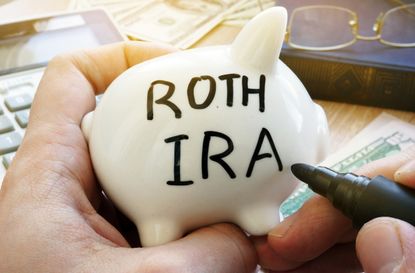Be Roth Smart: An Investment Guide to Roth IRAs
Roth IRAs are the closest thing we have to tax-free retirement savings out there, so make sure you take full advantage. Here is how Roths work and three ways to get money into them.


Twenty years ago, a mind-blowing paradigm shift hit the American investment scene: retirement accounts with essentially no tax. This innovation was called the Roth IRA.
Roth IRAs were created to incentivize individuals to better prepare for retirement by allowing them to save after-tax earnings in an account where it was possible to withdraw contributions and earnings completely tax-free throughout retirement.
Because of this advantage over other investment vehicles, almost everyone should consider Roth IRAs as a core component of saving and spending plans for retirement. The potential growth of tax-free returns compounding over prolonged periods of time is significant and can potentially eliminate the government’s role in your retirement.

Sign up for Kiplinger’s Free E-Newsletters
Profit and prosper with the best of expert advice on investing, taxes, retirement, personal finance and more - straight to your e-mail.
Profit and prosper with the best of expert advice - straight to your e-mail.
But how did this incredible investment option come to be? And how could you take full advantage? Let’s dig deeper.
First, a Brief History of the Roth IRA
Roth IRAs were born out of the 1997 Taxpayer Relief Act and named after Sen. William Roth of Delaware, who co-authored the bill. Back then, the contribution limit was set at $2,000, with the hope that these new accounts would encourage workers to save more for retirement.
Over the past 20 years the Roth IRA has evolved:
- In 2001, Congress modified the contribution limits to increase with inflation and added “catch-up” contributions of $1,000 for workers 50 and older.
- In 2002, rollovers of after-tax money in employer plans to Roth IRAs became available.
- In 2006, the Roth 401(k) and 403(b) were created, but only accessible if offered by an employer.
- In 2008, the conversion of a traditional IRA to a Roth IRA was allowed for individuals with adjusted gross incomes (AGI) under $100,000.
- In 2010, the government repealed the $100,000 AGI limit on Roth IRA conversions, opening up the possibility of creating tax-free retirement accounts to a significantly larger audience.
- In 2018, the Tax Cuts and Jobs act eliminated the option to recharacterize a Roth IRA conversion. A recharacterization effectively allowed an individual to “undo” a Roth conversion if they changed their minds after completing the conversion.
Despite 20 years of meaningful evolution and improved accessibility, the goal of a tax-free (or at least tax-reduced) retirement remains only a pipe dream for most savers. According to the Investment Company Institute, only 50% of individuals with IRAs today have a Roth IRA, and only 9% of all IRA assets are held in Roth accounts. So, if you are part of the 50% of the population who don’t have a Roth IRA yet, let me lay out how you can make a Roth IRA work for you.
How to Get Money Into a Roth IRA
Generally, there are three ways to fund a Roth IRA account: contributions, rollovers and conversions.
Contributions
You must be working to contribute to a Roth IRA, because having earned income is a requirement. Annual contributions are limited to the amount of income earned or $5,500 ($6,500 if over age 50) — whichever is lower. You can continue to contribute indefinitely, so long as you have earned income (unlike a traditional IRA, which eliminates contributions once you turn age 70.5). Non-working spouses can also make contributions based on the earned income of their working spouses. The ability to make direct Roth IRA contributions begins to phase out when your AGI is over $120,000 if single and $189,000 if married filing jointly.
If you are unable to make a direct Roth IRA contribution and do not have a separate traditional IRA, a “backdoor” Roth IRA contribution may be beneficial. This strategy involves two separate transactions: a non-deductible contribution to a traditional IRA, followed by a Roth IRA conversion. When the conversion occurs, taxes are paid on any increase in the traditional IRA in excess of the non-deductible contribution when the conversion occurs.
Rollovers
A rollover is the second most common method for getting money into a Roth IRA. This funding method applies when you have already made contributions to a Roth-type account — such as a Roth 401(k) or a 403(b) — through your employer. Upon retirement, separation from service or potentially while you are still working (if your employer allows it), you can transfer the balance of this account directly to a Roth IRA. Remember, Roth employer plans and Roth IRAs each have unique attributes that should be evaluated prior to making any rollover decision.
Conversions
The least common, but often the most effective, method for funding a Roth IRA is via a Roth conversion. A Roth conversion requires that you have an existing balance in a tax-deferred account (e.g., a traditional IRA or a pre-tax employer plan). When you convert, you move the money from the tax-deferred account to a Roth IRA, and the amount transferred gets treated as taxable income. After the taxman is paid, any future appreciation on the funds inside the account will avoid taxes going forward. Unlike a Roth IRA contribution, with a Roth conversion there is no earned income requirement nor a minimum or maximum amount you can convert (however, be sure that you can pay the tax bill that comes with a big conversion without causing yourself any problems). Therefore, anyone with a qualified pre-tax retirement account can take advantage of a Roth IRA conversion.
In most circumstances, doing strategic partial conversions of an account over time makes the most sense. These conversions are most beneficial during low-income years, especially after retirement during the period before you start collecting Social Security, as your taxable income (and tax rates) may drop substantially. By completing one conversion at that time, you get multiple tax benefits: paying tax at a lower rate and reducing future required minimum distributions (RMDs) — which, of course, are taxable — when you turn 70.5 and are forced to start withdrawing savings from these pre-tax retirement accounts.
How to Get Money Out of a Roth IRA
Roth IRAs provide wonderful flexibility when it comes to accessing your money. With a traditional IRA, you would have to pay taxes and a 10% penalty on any withdrawals you make before age 59.5. With a Roth IRA, on the other hand, you can withdraw any amount of your contributions (but not the earnings) at any age without paying any taxes or penalties. This is a huge opportunity, especially if you’re crafting a retirement income plan that starts before age 59.5. If you need to withdraw the investment earnings on those contributions, however, you can only do so tax- and penalty-free as long as you are over age 59.5 and have owned the account for at least five tax years.
Withdrawals of previous Roth conversion amounts (but not any earnings) are not subject to income tax regardless of age, because the tax was paid at the time of the conversion. If you withdraw the converted amount before age 59.5, however, you may be subject to penalty if the withdrawal occurs within the first five years of the conversion. Whether the earnings on the converted amounts are subject to tax is dependent on the age and time of the distribution relative to the conversion date. If you are under age 59.5, the earnings on the converted amounts are generally subject to tax and/or penalty. If you are over age 59.5, income tax is only assessed if the earnings are withdrawn prior to holding the converted amount for at least five years. Penalties are never assessed on distributions of earnings when over age 59.5.
Another withdrawal advantage of a Roth IRA is that there are no RMDs once you turn 70.5. This benefit is especially powerful for those retirees who will not spend all of their savings during their lifetime as it allows additional tax-free savings to compound not just for you but your inevitable beneficiaries.
When Does a Roth IRA Make Sense?
The whole point of using a Roth IRA and having an individualized tax strategy is to take advantage of tax rate arbitrage, meaning that you pay tax at a lower rate at the time of the contribution/conversion than you otherwise would when you take withdrawals from your tax-deferred retirement accounts. Leaving too much money in a traditional IRA can create an issue when you go to take RMDs.
If your RMDs exceed your lifestyle spending and extra income pushes you into a higher tax bracket, you’ll be forced to pay a bigger tax bill on your retirement savings. By utilizing a Roth conversion at a time when you are in a lower tax bracket, you pay the lower rate, reduce future RMDs and withdraw your investments’ earnings tax-free. It’s a win-win-win.
But a Roth conversion strategy requires a thoughtful approach to take advantage of your tax arbitrage opportunity. If you’re at the height of your career, it’s likely not an ideal time to make a Roth conversion, as you’re likely in the highest tax bracket you will ever be in. However, if you are early in your career, now may be a great time to open a Roth IRA and start contributing with plenty of time to see your savings grow.
On a similar note, if you are a recent retiree or have reduced income, recent tax reform has made Roth conversions even more attractive. With lower rates and expanded tax brackets, taxes are “on sale.” This means that this could be a great time to integrate a tax-free strategy as part of your broader financial plan.
Another perk with Roth IRAs is that you can pass them down to your children, who will continue to benefit from tax-free growth as well. Even though Roth IRA beneficiaries have to start RMDs, a Roth IRA can be the most tax-efficient asset that you can pass on to your children or grandchildren as a part of your estate plan.
How has a Roth IRA invested in the S&P 500 fared over the past 20 years?
Rewind yourself back to 1998 with all of the Y2K hysteria and pretend you’ve saved $2,000 into a Roth IRA and $2,000 into a taxable investment account. For the next 20 years, let’s assume both accounts are invested in the S&P 500 and that dividends are reinvested for which the taxable account pays tax (28% for 1998-2002, 15% for 2003-2017). Let’s also assume both investments are sold on Jan. 1, 2018, and that gains in the taxable account are subject to a 15% tax rate. This allows us to compare the after-tax balance of the taxable account with the Roth IRA balance over that same time period.
After the 1998-2018 period, the Roth IRA accumulated 20% more wealth than the taxable investment account. Despite the bursting tech bubble and financial crisis, the Roth account grew from $2,000 to $8,021 while the taxable account was only worth $6,701. That’s a good chunk of change and a great real-world example of the potential impact of a Roth IRA.
Be Roth Smart
Creating tax-free money in a Roth IRA can be a powerful strategy, but it needs to be done in the context of a broader financial plan because saving in a Roth IRA or completing a Roth IRA conversion will have impacts on your cash flow and retirement spending options. Generally, when you have a Roth IRA it becomes your most tax-efficient asset, and thus you may want to preserve that asset over the long term. As a result, it’s often the case that the Roth money becomes the best asset for leaving as part of your estate, so it’s important to keep in mind that any contributions/conversions may ultimately benefit your beneficiaries more than they benefit you.
If you are considering utilizing a Roth IRA as a part of your retirement plan, here are a few questions to ask your financial adviser or tax specialist to make sure you are on track:
What percentage of your retirement is in tax-free accounts?
How does your multiyear path for creating a tax-free retirement respond to new tax laws?

Brian Vnak is Vice President, Wealth Enhancement Group, advising clients on income, gift, trust and estate tax issues.
-
 Starbucks BOGO and New Sweet and Spicy Drinks
Starbucks BOGO and New Sweet and Spicy DrinksFor a limited time, Starbucks is announcing four new "swicy" drinks that are both spicy and sweet.
By Kathryn Pomroy Published
-
 Stock Market Today: Dow Slips After Travelers' Earnings Miss
Stock Market Today: Dow Slips After Travelers' Earnings MissThe property and casualty insurer posted a bottom-line miss as catastrophe losses spiked.
By Karee Venema Published
-
 Charitable Remainder Trust: The Stretch IRA Alternative
Charitable Remainder Trust: The Stretch IRA AlternativeThe SECURE Act killed the stretch IRA, but a properly constructed charitable remainder trust can deliver similar benefits, with some caveats.
By Brandon Mather, CFP®, CEPA, ChFEBC® Published
-
 Three Ways to Take Control of Your Money During Financial Literacy Month
Three Ways to Take Control of Your Money During Financial Literacy MonthBudgeting, building an emergency fund and taking advantage of a multitude of workplace benefits can get you on track and keep you there.
By Craig Rubino Published
-
 How Did O.J. Simpson Avoid Paying the Brown and Goldman Families?
How Did O.J. Simpson Avoid Paying the Brown and Goldman Families?And now that he’s died, will the families of Nicole Brown Simpson and Ron Goldman be able to collect on the 1997 civil judgment?
By John M. Goralka Published
-
 What Not to Do if an Employee or Loved One Is Kidnapped
What Not to Do if an Employee or Loved One Is KidnappedBusinesses need to have a crisis plan in place so that everyone knows what to do and how to do it. Sometimes, calling the authorities isn’t recommended.
By H. Dennis Beaver, Esq. Published
-
 Why You Shouldn’t Let High Interest Rates Seduce You
Why You Shouldn’t Let High Interest Rates Seduce YouWhile increased interest rates are improving the returns on high-yield savings accounts, that may not be an effective place to park your money for the long term.
By Kelly LaVigne, J.D. Published
-
 Need to Build an Emergency Fund? Seven Steps to Get There
Need to Build an Emergency Fund? Seven Steps to Get ThereHaving a safety net can mean peace of mind on top of being able to maintain your lifestyle if a financial emergency strikes.
By Justin Stivers, Esq. Published
-
 Which Type of Life Insurance Is Right for You?
Which Type of Life Insurance Is Right for You?Life insurance isn’t a one-size-fits-all option. Here are the differences between term life, whole life and indexed universal life insurance.
By Jay Dorso Published
-
 What Happens Financially When You Work One More Year?
What Happens Financially When You Work One More Year?The impact of saving more, spending less later and benefiting from an extra year or more of compounding can be truly staggering.
By Andrew Rosen, CFP®, CEP Published